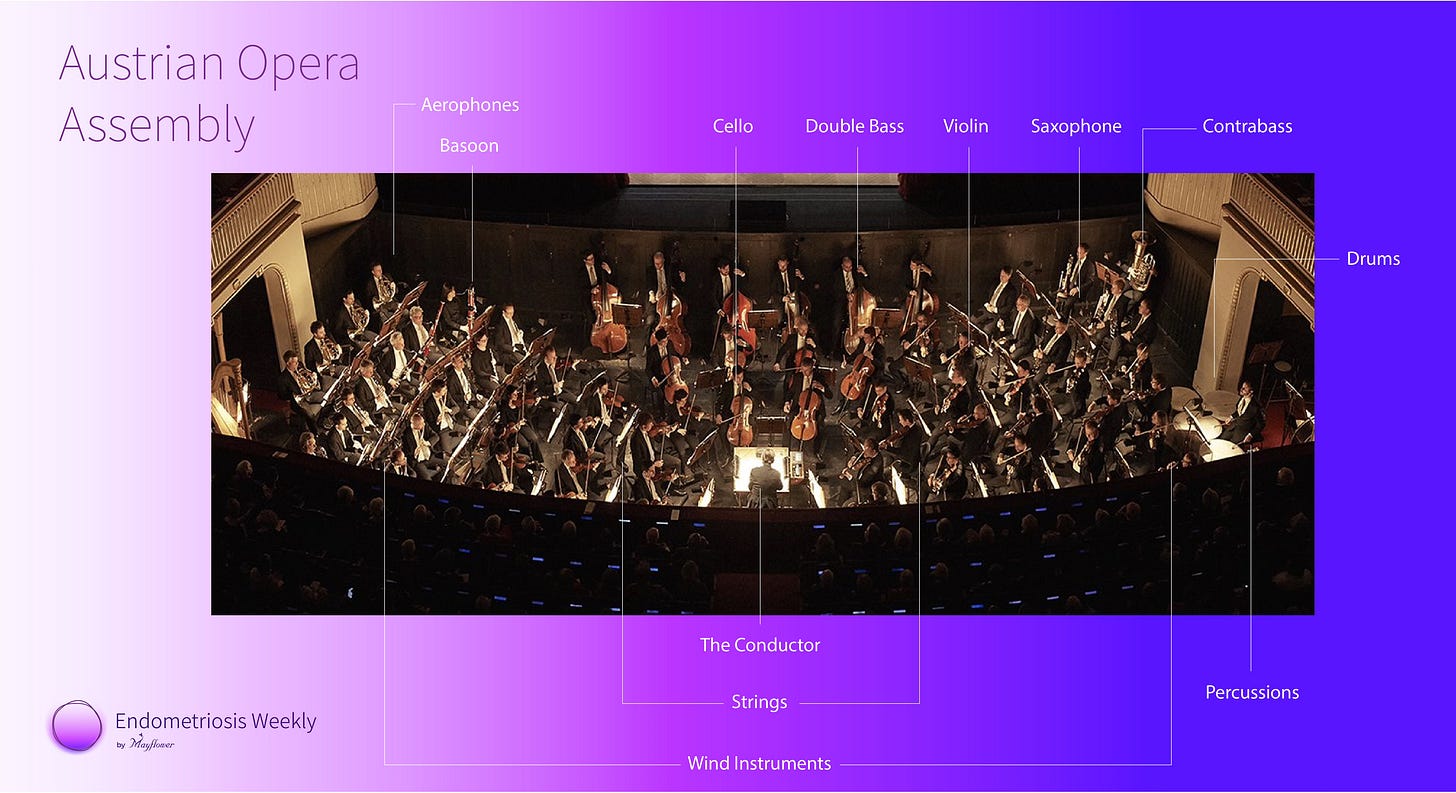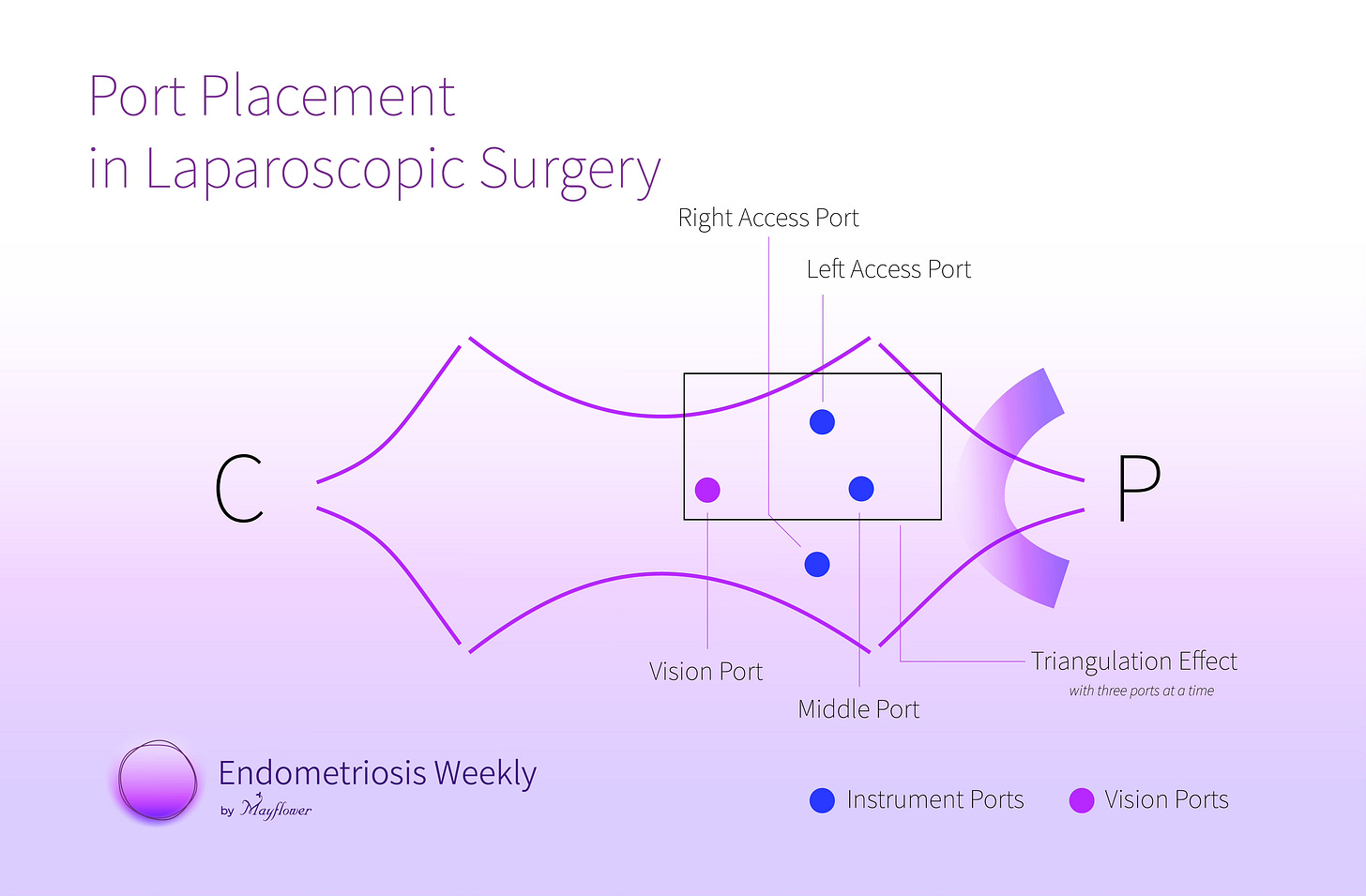The Perfect Port Placement: An analogy in Music
Last week we had a chance encounter with an opera, and out came this newsletter
Opera Music and Laparoscopic Port Placements have something in common
What can opera music teach us about laparoscopic surgery? Humans, especially the smart ones, use the same principles everywhere to get the job done. When you look carefully at how experts in various fields operate, you might find more similarities than you would find differences.
Right before our last night in Vienna, we got the opportunity to grab some box seats at the State Opera House. Known for its long tradition of operatic music and in some ways the birthplace of an entire school of western classical music, the Vienna State Opera House is a sight to behold. Photography wasn’t allowed so this is sourced from the internet but look carefully at the arrangement of people.
If you aren’t familiar with musical instruments, that’s okay. We’ll label the image and make it easy for you to understand.
In the middle is the man who is in charge of the music. The Conductor as they call him. Think of him as the centre, the eye, the source of the music.
Closest to him are all the string instruments. Violins, Cellos, Double Basses, and so on. The most sensitive, impulsive instruments that hold the melody together, set the mood and the direction of the musical piece.
Just outside are the wind instruments. The flutes, saxophones, bassoon, contrabass, and so on. These instruments hold together the body of the music. Without them, violins and strings would sound annoying, and directionless.
And in the outermost ring, you can see the percussionist on the right. Big drums that give beat, and punctuate very important moments in the music, and the story it is trying to tell.
Together, they produce perfect harmonies; and there’s a reason they are arranged this way.
Sure, you can jumble them up and they can all still follow the same notes, and the music will play. But it won’t play the same. How it sounds has a lot to do with how the instruments are placed.
A conductor doesn’t tell the orchestra what to play. They already know the notes. Instead, he tells them how to play. Softly, harshly, happily, sadly, like you’re running away from the police, or like you’re holding a baby in one hand.
The string instruments catch this first and are most sensitive to changes in the style of play. So they’re placed the closest, The wind instruments are important, but follow suit and have less variability in how they’re being played. And like that, others follow.
There are aspects of music, you can’t write in notes. And there are aspects of surgery you can’t write in SOPs.
Like on the stage of the Vienna State Opera, there is yet another orchestra that gathers around in the operating room with each surgery. With instruments like vision systems, bipolar, ultrasonic scalpels, uterine manipulators, and more.
And when you think of the perfect dissection, the perfect cut, it cannot happen unless you have the perfect setup and the perfect preparation.
The first principles of surgery, proper traction and counter traction play a critical role in determining the precision and quality of surgery, which in turn determine the extent of anatomical restoration, and subsequently the objective of the surgery - a better quality of life.
Port placement is crucial in helping us achieve the right surgical setup. So let’s begin by looking at how we arrange our orchestra.
The process begins with placing the primary port. One that is used for vision. This is our conductor. Having uniform and pervasive visual access in the centre of the stage that is the pelvis, is crucial for getting the right angle for dissection and hand-eye coordination.
Primary Port Placement
At Mayflower, we put our primary port through the umbilicus where we use a Zero Degree vision 3D.
In the case where one is using 30 degree vision the port placement has to be above umbilicus or the vision probe might strike the middle port instrument which is typically the port we use for energy sources or primary probes owing to the middle port’s versatility across the pelvis..
If you are to use an ipsilateral port instead, then a vision pot through the umbilicus will work just fine.
Secondary Port Placement
Secondary port placement is the most vital step in ensuring case-to-case access based on disease involvement for each case.
Putting the port at the correct position therefore is the most important part of surgery ensuring an ease of doing surgery. The aim here is to create a triangulation effect between vision, left hand instrument, and the right hand instrument.
Placing the Middle Port - The Violins of our Orchestra
Consider primary port as z axis
We use middle port as our primary instrument port; a port we use to dissect, coagulate, and cut. It’s the most versatile port on our hands.
Being along the midline allows access to both sides of pelvis with significant degrees of freedom of movement on either side.
Typically, the middle port is 2-3 fingers above the pubic symphysis, but we can adjust this position according to the size and nature of the disease. What’s important to keep in mind however is bladder injury. Vision guided incision can easily keep the bladder safe in the process of port placement.
Next, consider the middle port as an x axis
The Lateral Ports - The Flutes of our Orchestra
Lateral or assistive ports are critical in providing traction and counter traction in the process of surgery. Placing them such that they can easily reach the probe placed through the middle probe is key to a comfortable surgery.
The left hand instrument enters through the left flank port. It’s position is roughly 4 fingers from the ASIS (Anterior Superior Iliac Spine) along the imaginary line joining ASIS and the Umbilicus.
This port is vital in providing traction to dissections being conducted through the middle port. As a corollary, the counter traction comes from the right flank port.
Similarly the right port position is roughly 4 fingers from asis ( anterior superior iliac spine ) along the imaginary line joining asis and umbilicus on the other side.
These port placement are for ideal conditions, and for most cases they work just fine, however from time to time, disease occurrence might make it wiser to slightly alter port placement for a better ease of surgery.
Port Variations
The pelvis is a pandora's box, so once we enter through the primary port, the first thing we do is inspect the space and then decide where the other ports will be. Some cases in the past have required an additional supra umbilical port for better vision.
In another edition, we will dive deeper into traction and countertraction, and how they can help us dissect better.
And if we’ve succeeded in peaking your interest in operatic music, here’s a great video explainer of how it works
That’s it! That’s all for this week. See you next Wednesday!









Beautiful and out of the box thinking! Am totally in sync with such thought processes and analogies!